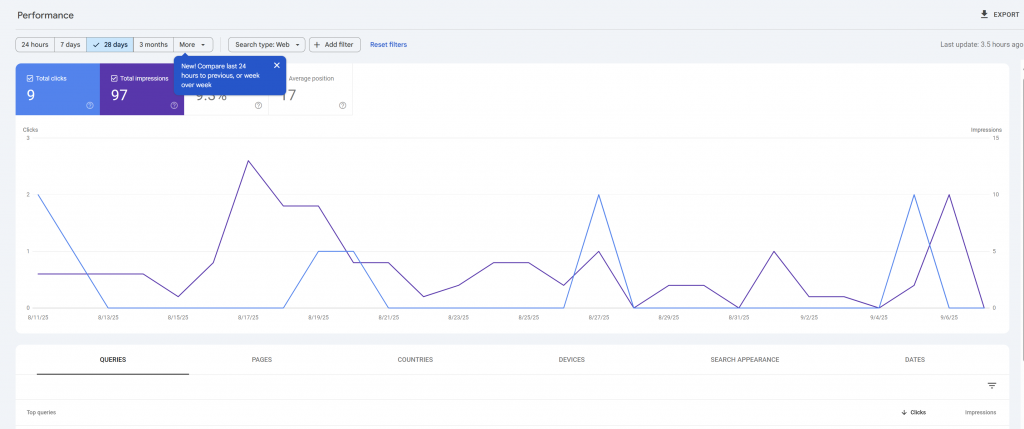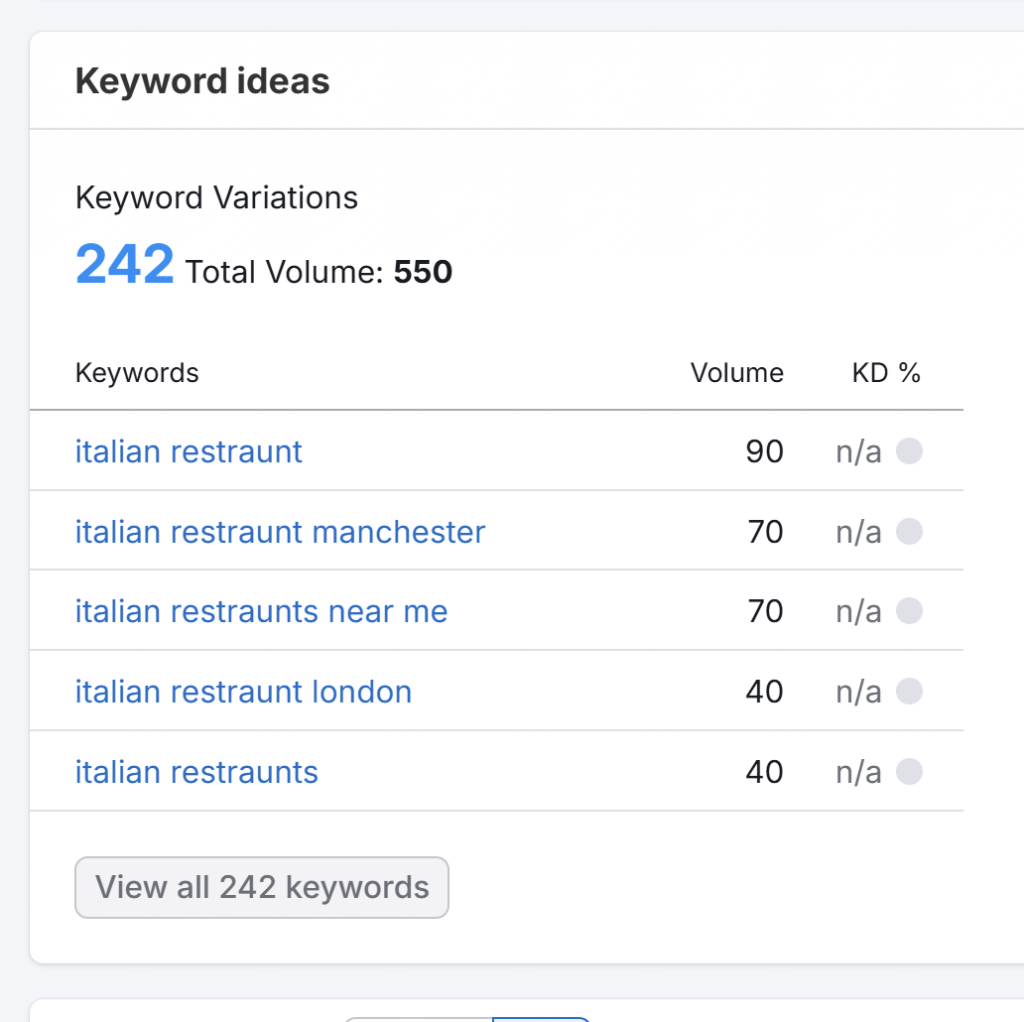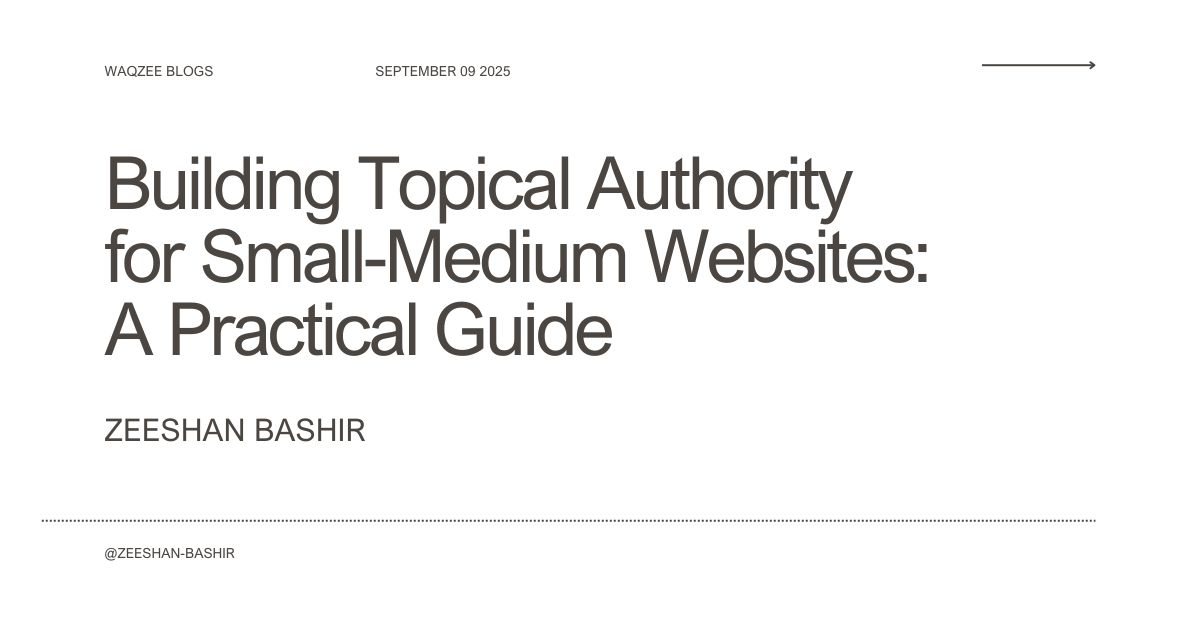How resource-limited websites can compete with industry giants through strategic topical relevance
Why Small Business Websites Struggle with Topical Authority
Your articles disappear into the void while competitors with million-dollar budgets dominate page one. This happens because small business websites make a critical mistake: they chase individual keywords instead of building comprehensive topical relevance.
Learning how to build topical authority for small business websites solves this problem. It means becoming the go-to expert on specific topics instead of a mediocre generalist competing on everything.
Step 1: Think Topics, Not Keywords
Stop targeting individual keywords. Start building content around topics.
When you search “how to outline a book” and “how to start writing a book,” Google shows mostly the same results. That’s because Google sees these as the same intent: helping people learn how to write a book.
The old approach creates separate articles for each keyword variation. This wastes effort and splits your authority. The new approach creates one comprehensive piece covering the entire topic.
Topics are clusters of keywords sharing the same search intent. Building around topics increases your content efficiency and ranking potential because you address complete user intent instead of fragments.
Step 2: Find Your Existing Keywords with Google Search Console
Most small business websites already have hidden topical authority. You need to identify it.
Open Google Search Console. Go to Performance → Search Results. Export your top 100 queries from the last three months.
Look for patterns in these keywords. Do you see repeated themes? Groups of related terms? These clusters show where Google already recognises your topical relevance.
If you have fewer than 20 ranking keywords total, focus on brand marketing and paid ads first. SEO content works best when you have some existing foundation to build upon.

Step 3: Identify Your Topical Authority Themes
Analyse your keyword data to find themes representing your areas of authority.
Look for word patterns in your top-performing keywords. Group related terms together. For example, if you run a marketing agency, you might see clusters around “email marketing,” “social media strategy,” or “content creation.”
Identify your top 3 non-branded themes. These represent topics where your business already has some authority.
Choose one theme that avoids these common mistakes:
- Low volume topics: For small businesses, even 20-100 monthly searches can be valuable, but ensure there’s genuine demand
- Ultra-competitive topics: Avoid topics dominated by competitors with 60+ domain authority
You can run a Python script to automate this step. Connect to the Google Search Console API (recommended) or upload a CSV file and run the following code to make the process more efficient.
import pandas as pd
import numpy as np
from collections import Counter, defaultdict
import re
from sklearn.feature_extraction.text import TfidfVectorizer
from sklearn.cluster import KMeans
import matplotlib.pyplot as plt
class KeywordThemeAnalyzer:
def __init__(self, csv_file_path=None):
"""
Initialize analyzer with keyword data
Expected CSV columns: 'keyword', 'impressions', 'clicks', 'position'
"""
if csv_file_path:
self.df = pd.read_csv(csv_file_path)
else:
# Sample data structure
self.df = pd.DataFrame()
def load_sample_data(self):
"""Load sample data for demonstration"""
sample_data = {
'keyword': [
'email marketing tips', 'social media strategy', 'content creation tools',
'email automation', 'facebook marketing', 'blog content ideas',
'instagram strategy', 'email campaigns', 'content marketing',
'social media tools', 'email marketing software', 'content planning'
],
'impressions': [1500, 2300, 800, 1200, 1800, 600, 1400, 900, 2100, 1100, 1300, 700],
'clicks': [120, 180, 65, 95, 140, 45, 110, 70, 165, 85, 100, 55],
'position': [8.5, 6.2, 12.1, 9.8, 7.3, 15.2, 8.9, 11.4, 5.8, 10.3, 9.1, 13.6]
}
self.df = pd.DataFrame(sample_data)
return self.df
def preprocess_keywords(self):
"""Clean and prepare keywords for analysis"""
# Remove brand terms (customize this list)
brand_terms = ['your-brand', 'company-name'] # Add your brand terms
# Filter out branded keywords
pattern = '|'.join(brand_terms)
if pattern:
self.df = self.df[~self.df['keyword'].str.contains(pattern, case=False)]
# Calculate CTR and weighted score
self.df['ctr'] = (self.df['clicks'] / self.df['impressions']) * 100
self.df['weighted_score'] = self.df['clicks'] * (21 - self.df['position']) / 20
return self.df
def extract_themes_simple(self, min_volume=20):
"""Extract themes using simple word frequency analysis"""
# Get top performing keywords (top 50% by weighted score)
top_keywords = self.df[self.df['weighted_score'] >= self.df['weighted_score'].median()]
# Extract important words (remove common stop words)
stop_words = {'the', 'and', 'or', 'but', 'in', 'on', 'at', 'to', 'for', 'of', 'with', 'by', 'how', 'what', 'best', 'top'}
all_words = []
for keyword in top_keywords['keyword']:
words = re.findall(r'\b\w+\b', keyword.lower())
words = [w for w in words if len(w) > 2 and w not in stop_words]
all_words.extend(words)
# Count word frequency
word_freq = Counter(all_words)
# Group keywords by common themes
themes = defaultdict(list)
theme_scores = defaultdict(float)
for _, row in top_keywords.iterrows():
keyword = row['keyword']
score = row['weighted_score']
# Find dominant theme for this keyword
keyword_words = set(re.findall(r'\b\w+\b', keyword.lower()))
best_theme = None
max_relevance = 0
for word in keyword_words:
if word in word_freq and word_freq[word] >= 2:
if word_freq[word] > max_relevance:
max_relevance = word_freq[word]
best_theme = word
if best_theme:
themes[best_theme].append(keyword)
theme_scores[best_theme] += score
return themes, theme_scores, word_freq
def extract_themes_advanced(self, n_clusters=5):
"""Extract themes using TF-IDF and clustering"""
keywords = self.df['keyword'].tolist()
# TF-IDF Vectorization
vectorizer = TfidfVectorizer(
max_features=100,
stop_words='english',
ngram_range=(1, 2)
)
tfidf_matrix = vectorizer.fit_transform(keywords)
# K-means clustering
kmeans = KMeans(n_clusters=n_clusters, random_state=42)
clusters = kmeans.fit_predict(tfidf_matrix)
# Assign clusters to dataframe
self.df['cluster'] = clusters
# Analyze clusters
cluster_themes = {}
for cluster_id in range(n_clusters):
cluster_keywords = self.df[self.df['cluster'] == cluster_id]
# Get top terms for this cluster
cluster_center = kmeans.cluster_centers_[cluster_id]
top_indices = cluster_center.argsort()[-5:][::-1]
top_terms = [vectorizer.get_feature_names_out()[i] for i in top_indices]
cluster_themes[f"Theme_{cluster_id}"] = {
'keywords': cluster_keywords['keyword'].tolist(),
'top_terms': top_terms,
'total_impressions': cluster_keywords['impressions'].sum(),
'total_clicks': cluster_keywords['clicks'].sum(),
'avg_position': cluster_keywords['position'].mean()
}
return cluster_themes
def identify_top_themes(self, method='simple', min_keywords=3):
"""Identify top 3 non-branded themes"""
if method == 'simple':
themes, theme_scores, word_freq = self.extract_themes_simple()
# Filter themes with sufficient keywords
filtered_themes = {
theme: keywords for theme, keywords in themes.items()
if len(keywords) >= min_keywords
}
# Sort by score
sorted_themes = sorted(
filtered_themes.items(),
key=lambda x: theme_scores[x[0]],
reverse=True
)
return sorted_themes[:3], theme_scores
else: # advanced
cluster_themes = self.extract_themes_advanced()
# Sort by total clicks
sorted_themes = sorted(
cluster_themes.items(),
key=lambda x: x[1]['total_clicks'],
reverse=True
)
return sorted_themes[:3], cluster_themes
def analyze_competition_risk(self, theme_keywords):
"""Simple competition analysis based on average position"""
avg_position = np.mean([
self.df[self.df['keyword'] == kw]['position'].iloc[0]
for kw in theme_keywords if kw in self.df['keyword'].values
])
if avg_position > 15:
return "High competition risk - poor rankings"
elif avg_position > 10:
return "Medium competition risk"
else:
return "Good opportunity - decent rankings"
def generate_report(self):
"""Generate comprehensive theme analysis report"""
# Preprocess data
self.preprocess_keywords()
print(" KEYWORD THEME ANALYSIS REPORT")
print("=" * 50)
# Get top themes
top_themes, scores = self.identify_top_themes()
print(f"\n📊 TOP 3 NON-BRANDED THEMES:")
print("-" * 30)
for i, (theme, keywords) in enumerate(top_themes, 1):
print(f"\n{i}. THEME: '{theme.upper()}'")
print(f" Keywords ({len(keywords)}): {', '.join(keywords[:5])}")
if len(keywords) > 5:
print(f" ... and {len(keywords)-5} more")
# Calculate metrics
theme_data = self.df[self.df['keyword'].isin(keywords)]
total_impressions = theme_data['impressions'].sum()
total_clicks = theme_data['clicks'].sum()
avg_position = theme_data['position'].mean()
print(f" Total Impressions: {total_impressions:,}")
print(f" Total Clicks: {total_clicks}")
print(f" Avg Position: {avg_position:.1f}")
print(f" Competition: {self.analyze_competition_risk(keywords)}")
# Recommendations
print(f"\n💡 RECOMMENDATIONS:")
print("-" * 20)
best_theme = top_themes[0]
print(f"✅ FOCUS ON: '{best_theme[0].upper()}'")
print(f" This theme has the best performance with {len(best_theme[1])} related keywords")
Step 4: Brainstorm Adjacent Content Topics
Once you’ve identified your core topical authority, expand strategically into related areas.
Think about adjacent problems your audience faces. If your authority is “email marketing for restaurants,” related topics might include “restaurant customer retention,” “food photography for marketing,” or “restaurant loyalty programs.”
Brainstorm 5-10 adjacent topics that connect logically to your core authority. Use Ahrefs or Semrush to research search volume for each topic.
Focus on topics where you can leverage your existing expertise while serving your audience’s broader needs.

Step 5: Prioritise Your Adjacent Topics
Not all adjacent topics deserve equal attention. Prioritise systematically using three criteria.
Potential Traffic (Monthly Searches) Research the top-ranking page for each topic. Use Ahrefs to find its monthly traffic. This shows your potential if you create better content.
Estimated Topical Authority (1-5 Scale) Rate how closely each adjacent topic relates to your established authority:
- 5: Very similar activity, different format (email automation vs email marketing)
- 3: Different activity, logical succession (email design vs email marketing)
- 1: Quite different topic altogether (social media vs email marketing)
Business Value (1-5 Scale) Rate your confidence that traffic from this topic will convert:
- 5: Directly aligned with your business model
- 3: Somewhat related, could nurture prospects
- 1: Educational content unlikely to convert immediately
Create a simple spreadsheet scoring each topic. Focus on topics scoring high across all three criteria.
Step 6: Build Your Content Cluster Architecture
Transform your prioritised topics into a connected content system.
Create one comprehensive pillar page covering your main topic. Make it 3,000+ words addressing all major aspects at a high level. Think “Complete Guide to Email Marketing for Restaurants.”
Build 5-8 supporting articles diving deep into specific subtopics. Each should be 1,500+ words. Examples: “How to Automate Birthday Emails for Restaurant Customers” or “Email List Building Strategies for New Restaurants.”
Link everything strategically. Every supporting article should link to your pillar page and related supporting articles. This internal linking structure signals strong topical relevance to Google.
Step 7: Work Within Your Small Business Budget
Resource-limited businesses can’t publish daily. Focus on strategic content distribution to build topical authority effectively.
Allocate your content effort strategically:
- 40% bottom-funnel content (targeting people ready to buy)
- 30% middle-funnel content (helping people research solutions)
- 20% top-funnel content (catching people discovering problems)
- 10% pure authority content (case studies, industry insights)
This ensures immediate ROI from converting content while building long-term authority through educational pieces.
Repurpose content efficiently. Turn client work into case studies. Document your processes as how-to guides. Interview industry experts for quote-rich articles.
Step 8: Leverage External Platforms for Authority Building
Building topical authority isn’t just about your website. Establish expertise wherever your audience gathers.
Reddit increasingly appears in Google results. Find subreddits where your audience asks questions. Read the community rules and spend a few days observing the culture before participating. Then provide genuinely helpful answers without promoting yourself.
LinkedIn works for B2B topics. Share insights, comment thoughtfully on industry posts, and engage in meaningful discussions.
Guest posting on established sites in your niche builds backlinks and exposes you to new audiences while reinforcing your topical authority.
Step 9: Track Your Topical Authority Progress
Building topical authority for small business websites requires measuring the right metrics. Topical relevance shows up as ranking improvements across multiple related keywords, not just single keyword positions.
Monitor these metrics monthly:
- How many topic-related keywords you rank for
- Your average ranking position across all topic terms
- Which articles drive the most topic-related traffic
- Your visibility for topic-related searches
Use Google Search Console for free tracking. Export data monthly and track ranking improvements across your topic cluster. Identify content gaps where competitors rank but you don’t.
Step 10: Fix Technical Issues That Block Authority
Authority content needs a solid technical foundation. Common problems that block small business websites include slow loading speeds, missing meta descriptions, poor internal linking, and missing XML sitemaps.
Use GTmetrix to check page speed. Fix the biggest issues first—compress images, remove unnecessary plugins, or upgrade hosting.
Install Yoast or RankMath to handle basic on-page SEO. These plugins guide you through optimising titles, descriptions, and content structure.
Create logical URL structures like yoursite.com/topic/subtopic/. This helps Google understand your content organisation and topical relevance.
Common Mistakes That Hurt Small Business Topical Authority
Don’t target keywords just because they have high search volume. They must relate to your business and audience needs.
Don’t ignore user experience for SEO. Slow sites and poor navigation kill conversions even with great rankings.
Don’t stuff keywords unnaturally. Write for humans first, optimise for search engines second.
Don’t neglect updating existing content. Fresh information keeps articles relevant and rankings strong.
Don’t expect overnight results. Topical authority builds over months of consistent, strategic effort.



